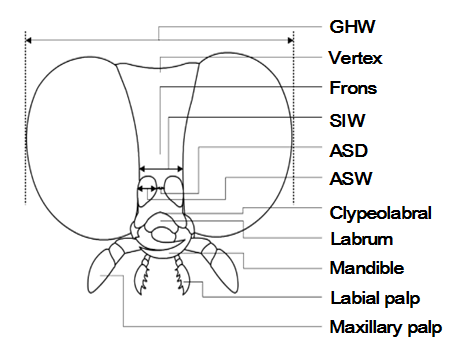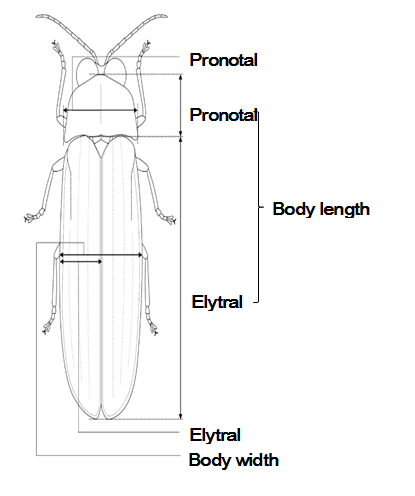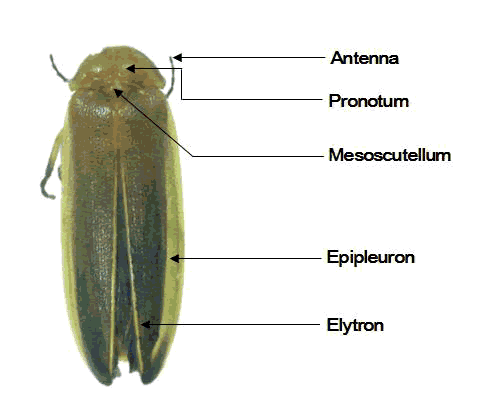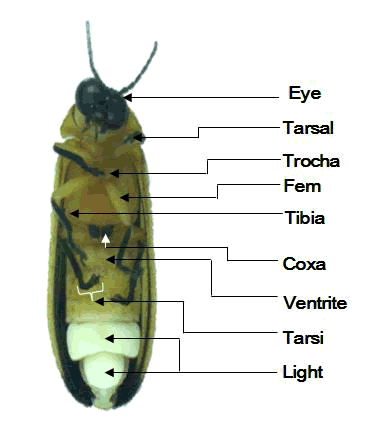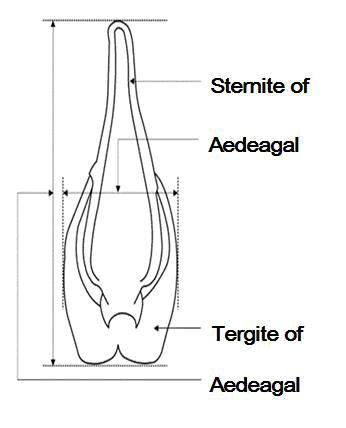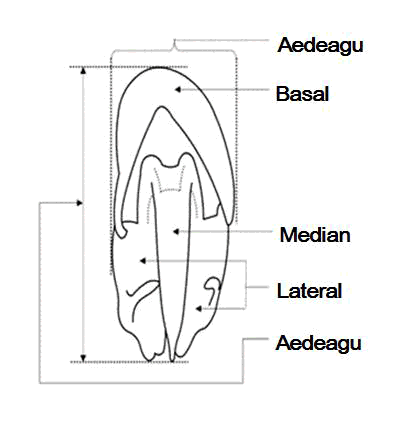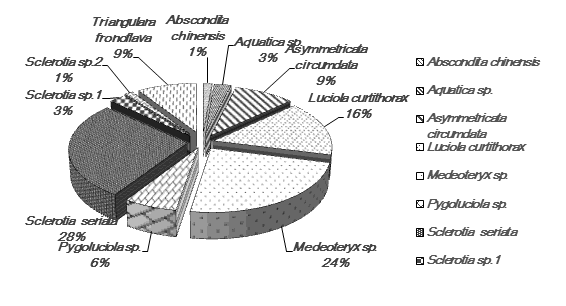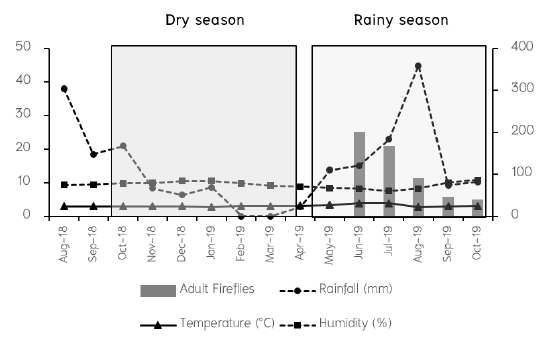Research Article: 2022 Vol: 21 Issue: 2S
Guidelines for Promoting Tourism From Biodiversity of Fireflies in Agricultural Areas of Ban-buo, Phayao Province, Thailand
Phanupong Chaiwongsaen, University of Phayao
Sitthisak Pinmongkhonkul, University of Phayao
Warach Madhayamapurush, University of Phayao
Keywords
Diversity, Agricultural Area, Firefly, Promoting Tourism, Phayao
Citation Information
Chaiwongsaen, P., Pinmongkhonkul, S., & Madhayamapurush, W. (2020). Guidelines for Promoting Tourism From Biodiversity of Fireflies in Agricultural Areas of Ban-buo, Phayao Province, Thailand. Academy of Strategic Management Journal, 21(S2), 1-13.
Abstract
The study of species diversity of fireflies in the Ban Bua agricultural area, Ban Toon sub-district, Muang district, Phayao province was conducted from October, 2018 to October 2019 with the objective to study on the species diversity of fireflies, physical factors and biological factors having effects on the species diversity in the Ban Bua agricultural area. Firefly samples were collected accounting for 100 adult fireflies by using the line transect sampling method in the area of 5 stations with different environments. From the study on 76 fireflies out of 100 fireflies which could be categorized, it was found that all of the fireflies belonged to subfamily Luciolinae consisting of 8 genus, namely Abscondita (1 firefly), Aquatica (2 fireflies), Asymmetricata (7 fireflies), Luciola (12 fireflies), Medeopteryx (18 fireflies), Pygoluciota (5 fireflies), Sclerotia (24 fireflies) and Triangulara (7 fireflies). The first three species of fireflies found the most were Sclerotia seriata (21 fireflies: 27.63%), Medeopteryx sp. (18 fireflies: 23.62%) and Luciola curtithorax (12 fireflies : 15.79%). Regarding the assessment result from the species diversity index of the fireflies, factors, physical factors and biological factors, it was found that forest areas at the edge of the canal near the reservoir were suitable for species diversity and abundance of fireflies whereby the values of the species diversity index, the species richness index, the evenness index and the species abundance were equal to 1.525, 1.500, 0.450 and 91.667 respectively. The species diversity and abundance of fireflies were found mostly in natural conditions with rather good environmental quantities. Conservation planning consisted of participatory plan preparation of the community based on geographical maps and promotion development to be learning resources and ecological tourist attractions with 2 steps of management: 1) At the initial stage, prepare a handbook of knowledge regarding fireflies, maps and the life cycle having an effect on ecoscape, including using the location for study tour of the youth in Phayao province on ecotourism; 2) Make arrangement for promoting tourist attractions through presenting on online social media and using influencers in presenting tourist attractions.
Introduction
Thailand has been classified as an important source of biodiversity because of having high species diversity of insects in terms of the number of types and quantities (Idris et al., 2021; Jaikla et al., 2020). However, no complete data have been provided regarding the number of types and the species diversity of insects. This is due to the fact that there are insects in every region of the country and the environment has been changing rapidly caused by the nature and human actions. This affects natural balance and richness of living things (Cardoso et al., 2020).
Fireflies are beetles which can glow in the dark by using special fluorescent organs in their abdomen to produce light (Day et al., 2009; Nune et al., 2020). Fireflies are natural pests helping eliminate snails which are habitats of parasites carrying diseases such as meningitis, opisthorchiasis etc (Cardoso et al., 2020; Fu et al., 2013; Fu et al., 2012). They are also a bioindicator whereby they live in sources of clean water and on the ground without pollution caused by chemicals (Jaikla et al., 2020; Kisi et al., 2015; Wang et al., 2018). Some species live in natural fresh water sources such as creeks, swamps, canals, ponds, rice fields or water logging areas (Kazama et al., 2007; Kisi et al., 2015). Some species live in brackish water sources along mangroves forests (Jaikla et al., 2020; Nukazawa et al., 2011). Larvae live on land and in water. Adults do not eat. Moreover, when fireflies mate at night, they flash beautifully (Moosman et al., 2009). This light from fireflies can be developed to be used for ecological tourist attractions (Rigakis et al., 2021; Wang et al., 2018). Currently the environment and the habitat of fireflies have been destroyed, caused by chemical contamination including rapid urban expansion. Light from houses and industrial plants interferes with reproduction of fireflies. These factors have reduced population of fireflies (Cardoso et al., 2020; Idris et al., 2021). Ban Bua, Bann Toon sub-district, Muang district, Phayao province is a sources of organic farming. Organic agriculture areas have high biodiversity due to the fact there are sources of waste, living things, utilizations of agricultural areas (Panprommin et al., 2019; White et al., 2004). Fireflies can be found but there has not been any survey conducted on firefly diversity and classification. There were important objectives for the research to be conducted as follows: conducting survey on species diversity and physical factors, namely temperature and relative humidity at the location where fireflies were found, planning firefly conservation and maintaining natural balance of the ecosystem, including development guidelines for promoting the location to be learning resources and ecological tourist attractions for the youth and the interested public further in the future.
Material and Method
The study on biodiversity of fireflies and development for agricultural tourism was conducted into 2 dimensions: Conducting survey on species diversities and physical factors, and development guidelines for promoting the location to be learning resources and ecological tourist attractions.
Study Areas
The coordinate of the study area was Ban Bua, Ban Toon sub-district, Muang Phayao district, Phayao province. It is about 20 kilometers far from Muang Phayao district. Most areas are agricultural areas. The study area was divided into 5 stations, namely the study area which is located at Ban Bua of the GPS coordinate 19.145782, 99.827623. Most areas are agricultural areas. The main occupation of the community is doing farming. For the study at this time, the paddy field based on organic substances, the common paddy field based on chemicals, the paddy field near natural water sources and the paddy field with man-made water resources. Before determining the point of study, the researcher surveyed the area with appearing fireflies and then determined the point of study in the area with abundant appearing fireflies in each study point. The study area was divided into 5 stations, namely Station 1: Paddy field near the community, Station 2: Hilly paddy field, Station 3: Paddy field adjacent to the irrigation dam, Station 4: Scenic point of fireflies of the village and Station 5: Forest areas at the edge of the canal near the reservoir.
Conducting a Survey of Fireflies in the Study Area
Data collection lasted all together 12 months starting from October 2018 to October 2019 by conducting the study 3 times per month. Data collection was determined during the waning moon of the month starting from the 8th day of waning moon of each month. Sampling of adult fireflies was conducted in the study area of 5 stations, lasting for 4 hours starting from 7 p.m. until 11 p.m. The technique used was Line Transect Sampling. The cruise line sampling was conducted on the area as a straight line. The distance of sample collection points was 20 meters apart. Data collection was conducted at a distance of 10 meters from the cruise line (Picture 8) by using the aluminium insect collecting net. Adult fireflies were caught by using the net to swoop down and then the bag was shaken off to be folded and closed in order to prevent the insects from passing through. The samples were put in the centrifuge tube with the size of 1.5 ml which contained 95% alcohol. The larvae were collected whereby they live and feed along ponds, creeks, ditches, patches of grass or damp areas and the study area. Forceps were used to pinch the samples to put them into the centrifuge tube with the size of 1.5 ml containing 95% alcohol. Information of day, month, year and collection location were recorded. Altitude from the sea level and geographical coordinates (GPS) were also recorded by using the Garmin instrument with the model Oregon 650.
Study on Physical Factors
1. Temperature and relative humidity were measured by using the DIGITAL THERMO-HYGROMETER in temperature measurement in the unit of °C and % for relative humidity.
2. Average amount of rainfall on the study area was recorded based on the data obtained from Phayao Metrological Department, Thailand.
3. Conductivity, Total Dissolved Solids (TDS), pH and Dissolve Oxygen (DO) values of water in the study area was measured by using a multi-parameter water quality monitor to measurement at a depth of about 3 centimeters from the water surface in each site.
Study on Biological Factors
The number of plants was recorded and plant samples were collected to be classified as perennials, vegetation on stream banks, marginal plants, floating plants. The study of food of fireflies was conducted and quantities were recorded. Samples were collected to be classified by collecting them at the bank of water sources and in water sources in the study area.
Study of Morphological Characteristics
The fireflies samples were analyzed to be categorized into species according to external characteristics under the stereo microscope with the brand Olympus model SZX7. Details were recorded such as shapes, characteristics, sizes and colors etc. Important taxonomical characteristics were checked by using diagnosis guidelines documents of fireflies species (Ballantyne et al., 2016). (Figure 1, 2, 3 & 4)
ASD Smallest distance between inner margins of antennal sockets
ASW Antennal socket width measured along the same horizontal line as for ASD
BP Basal piece of aedeagus
GHW Greatest head width (across eyes, measured parallel to ASD)
LL Lateral Lobes of aedeagus
LO Light organ
ML Median lobe of aedeagus
MPP Median posterior projection of ventrite 7
MS Mesoscutellum
PLP Posterolateral projections of posterior margin of ventrite 7
SIW Smallest Inter?ocular width (measured horizontally, may be on the same level as ASD, above it if the eyes are closer there)
T7, 8 etc. Visible abdominal tergites
V6, 7 etc. Visible abdominal ventrites, referred to by actual, not visible number
Study for Classification
The abdomen of the firefly was cut off and soaked in 10% KOH. Then, it was boiled on the hot plate for 10 minutes and removed the piece from the solution. The piece was soaked in distilled water and fat as well as parts which was not the sex organ was removed. Then, a sharp needle was used to gradually remove only the sex organ from the abdomen to soak in 75% and 95% alcohol respectively each for 5 minutes. The specimen was analyzed for species based on external characteristics and male sex organs under the Stereo microscope Olympus model SZX7. Then, details were recorded such as important characteristics of taxonomy by using diagnosis guidelines documents of fireflies species of Ballantyne, et al., (2016) (Figure 5 & 6).
Study on Development Guidelines of Promoting to be Learning Resources and Ecological Tourist Attractions
The study in the development dimension of promoting to be learning resources and ecological tourist attractions was taking the scientific data from the first objective going through the analysis to be developed and promoted to be learning resources and ecological tourist attractions through qualitative research and the research concept of the inductive method. In this, there were main informants, namely 4 community leaders (a village headman, a village scholar, the president of Ban Toon tourism group and the president of the farmer group), 1 firefly academician, 1 ecological academician, 1 tourism academician, 1 representative of the local government agency, 1 representative of Office of tourism and Sports, accounting for a total number of 8 people. The important instrument used in the research was focus group discussion. The important issues were guidelines of development and promotion to be learning resources and developing the location to be an important ecological tourist attraction of Phayao province.
Data Analysis
Relationship between firefly population and water quality level was determined by Pearson’s correlation test with a significance value p<0.05 as a reference and a coefficient of value (r). Ecological tourist attractions analysis used was content analysis.
Study on Firefly Species Diversity
Percentage of the number of adult firefly species found in the study area in the period of October, 2018 to October, 2019
The study results of firefly species diversity on the study area of the 5 stations in the period of October 2018 to October 2019 can be classified as follows: 1 Subfamily which is Luciolinae consisting of 5 Genus, such as Aquatica, Asymmetricata, Luciola, Medeopteryx and Pygoluciola and classification in to 10 species, Abscondita chinensis, Aquatica sp., Asymmetricata circumdata, Luciola curtithorax, Medeoteryx sp., Pygoluciola sp., Sclerotia seriata, Sclerotia sp.1, Sclerotia sp.2 ???Triangulara fronoflava. Regarding the number of adult fireflies species founded the most was Sclerotia seriata number for 21 fireflies (27.63%), followed by Medeopteryx sp. number for 18 fireflies (23.68%), Luciola curtithorax number for 12 fireflies (15.79%), Asymmetricata circumdata accounginf for 7 fireflies (9.21%)? Triangulara fronoflava number for 7 fireflies (9.21%), Pygoluciola sp. number for 5 fireflies (6.58%), Aquatica sp. number for 2 fireflies (2.63%), Sclerotia sp.1 accounting for 2 fireflies (2.63%) Abscondita chinensis accounting for 1 firefly (1.32%), Sclerotia sp.2 accounting for 1 firefly (1.32%).
Figure 7:Percentage of Species of Adult Fireflies Found At the Study Station During October 2018 to October 2019
Diversity Index and Abundance
Shannon Wiener's Index of the 5 study stations from October 2018 to October 2019, the study results revealed that Station 5 in June 2019 had the most diversity of adult fireflies (1.52) and station 4 in June 2019 had the least diversity of adult fireflies (0.50). the richness index from the results revealed that station 5 in June 2019 had the most species richness index value of adult fireflies (1.50) and station 2 in October 2019 had the least species richness index value of adult fireflies (0.33). The evenness revealed that station 5 in July 2019, adult fireflies had the most even distribution (0.45) and station 2 in September 2019, adult fireflies had the least even distribution (0.19). Abuncdance of species found that station 5 in June 2019, adult fireflies had the most abundance of species (91.66) and station 1 in July 2019, adult fireflies had the least abundance of species (8.33).
Ecological and Physical factors
In studying vegetation, the plot with the size of 4 x 4 meters accounting for 10 plots was used. Each point was randomly selected to be near water sources in each study area where fireflies were found whereby measurement was conducted along and away from the edge of the water at a distance of 10 meters. Each point was at least 20-50 meters far apart from each other (Pattama, 2557). It was found that all 5 stations had vegetation of 51 species, 24 families. The family Poacea was found at the most. The vegetation which had the most relative density was Imperata cylindrica, Mimosa pudica and Bidens pilosa with the relative density values of 15.53 13.24 and 12.76 respectively. The vegetation found to have the most relative density at station 1 was Cynodon dactylon. The vegetation found to have the most relative density at station 2 was Echinochloa colona. The vegetation found to have the most relative density at station 3 was Bidens pilosa. The vegetation found to have the most relative density at station 4 was Imperata cylindrical. The vegetation found to have the most relative density at station 5 was Mimosa pudica. The values were 8.41, 11.38, 12.76, 15.53 and 13.24 respectively.
The dry season from September 2018 to March 2019 had a small amount of average rain water and adult fireflies were not found. For the rainy season in May 2019 to October 2019, it was found that the month of August had the most amount of average rain water (360.00 ± 24.19 ml.). This was related to the increasing amount of abundance of fireflies in June 2019 (25.20 ± 20.69 fireflies). The amount of abundance of fireflies reduced according to the average amount of rain water from July (12.00 ± 6.93 fireflies), August (11.40 ± 7.73 fireflies), September (9.40 ± 8.17 fireflies) and October (5.80 ± 4.10 fireflies) (Figure 8).
Figure 8:Percentage of Species of Adult Fireflies Found At the Study Station During October 2018 to October 2019
Relationship between firefly species and physical factors found that at station 4, DO was positive correlated with Luciola curtithorax (r=0.922, p<0.01) and Medeopteryx sp. (r =0.922,p<0.01). Station 5, DO was negative related to Luciola curtithorax (r=-0.846, p<0.05), conductivity was positive correlated with Aquatica sp. (r=0.903, p<0.01), Asymmetricata circumdata (r=0.903, p<0.001), Medeopteryx sp. (r=0.921, p<0.01), Sclerotia seriata (r=0.903, p<0.01) and Triangulara fronoflava (r=0.903, p<0.01). TDS was positive correlated with Aquatica sp. (r =0.888, p<0.01), Asymmetricata circumdata (r=0.888, p<0.001), Medeopteryx sp. (r=0.907, p<0.01), Sclerotia seriata (r=0.888, p<0.01) and Triangulara fronoflava (r=0.888, p<0.01), and negative correlation with Luciola curtithorax (r=-0.809, p<0.05). Climatic values were positive correlated with Abscondita chinensis (r=0.987, p<0.01) and Luciola curtithorax (r=0.962**, p<0.01).
Results from the meeting of subgroups from 9 experts can be summarized into guidelines as follows:
1. The issue of developing the location to be learning resources and ecological tourist attractions
a. Academicians bring the data obtained from data collection in the area and academic data to be developed as handbook of knowledge regarding fireflies, maps and life cycles having an effect on the ecoscape. The manual must be made in duplicate, one for the instructor and the other one for the learner whereby it is made into infographic.
b. Village headmen, local scholars, presidents of Ban Toon tourism groups and presidents of farmer groups in cooperation with government agencies and academicians prepare tourism routes (tour map) for firefly sightseeing following the life cycle of fireflies for showing abundance of nature.
c. Local government agencies coordinate with schools in the area of capital districts to allow students of primary education and secondary education to organize activities learning about the life cycle of fireflies.
d. Village headmen, local scholars, presidents of Ban Toon tourism groups and presidents of farmer groups bring about natural resources conservation in the area.
e. Academicians make signs conveying meanings of natural tourist attractions following the life cycle of fireflies.
2. The issue of promoting learning resources and ecological tourist attractions
a. Office of tourism and sports of Phayao province promotes tourist attractions through presentation on online social media and using influencers in presenting tourist attractions.
b. Local Government agencies make tour maps in the system of GIS and Google Map.
c. Academicians organize training regarding presentation of natural tourist attractions following the life cycle of fireflies for the Ban Toon tourism group.
d. Office of tourism and sports of Phayao province in cooperates with presidents of Ban Toon tourism groups and academicians arrange a simulated tour in order to test readiness in providing services.
Discussion of Research Results
From the study, the number of firefly species Sclerotia seriata was found at the most (27.63%) and this type of firefly can be found commonly in Thailand. This is consistent with the study of Nak-eiam (2015) whereby this type of fireflies was found in Payao province. There is a report of finding fireflies of this genus in the central region and in the northeastern region of Thailand according to the previous report (Jaikla, Thancharoen et al., 2020). For the species Medeoteryx sp. (23.68%) and Luciola curtithorax (15.79%) were found secondary to that. Medeoteryx sp was found at the most on Station 5 (C=0.037) due to the fact that the area was adjacent to the dry evergreen forest. There were canals flowing through. This is consistent with the study of Nak-eiam (2015) making a survey and finding the firefly of Medeoteryx sp. in the area of dry evergreen forest in the area of Chang Rai province. Moreover, Station 5 was the area where diversity of fireflies was found at the most (H’=1.80) and there was the highest abundance (11.82 ± 6.76). The area had dry evergreen forests with a canal flowing from the Huay Mae Toon reservoir, making the area have high relative humidity (78.44±1.74) and low average temperature (23.79±0.76). The distribution of fireflies was found much on the area with high relative humidity Nak-eiam (2015). Species diversity of fireflies is related to relative humidity of the air and is found much at the beginning of the rainy season (Nopparat, B.E. 2013).
For Station 1, there was no species richness of adult fireflies and only one species was found. This may be due to the fact that the study area was near the community with interference from human activities, light form cars, light from roads and light from houses. These things affect reproduction behaviors of adult fireflies (Takeda et al., 2004). Female fireflies respond to male fireflies by flashing light. The increasing rates of response of female fireflies are likely to increase the possibility of male fireflies to mate successfully (Lewis and Wang, 1986). The environment receiving the impact from light (0.05-0.3 Lux) has an effect on prolonging the period of courting and the period of climbing up on top of the female fireflies. Therefore, it is likely that light has an effect on the fact that fireflies cannot mate naturally (Thancharoen, 2007).
In June, the average total number of adult fireflies’ abundance was at the most (25.20 ± 20.69). This is in line with the study of Takeda et al., (2004) finding the firefly Luciola cruciate at the most in June, abundance of the firefly Pyrocoelia praetexta at the most in June which is the beginning of the rainy season. Seasonal changes have an effect on appearing of fireflies (Nak-eiam, 2015). The increasing amount of rain water results in high humidity and reducing temperature. This is a suitable condition for the food of larvae of fireflies, namely water mollusks, snails, earthworms and millipedes. Therefore, increasing number of preys benefits development of fireflies at the larva stage (Nak-eiam, 2015). The number of adult fireflies will increase during the rainy season and there is a decreasing tendency upon entering the dry season (Thancharoen, 2001). Therefore, the amount of rain water is related to the amount of abundance of increasing fireflies at the beginning of the rainy season.
The quality of water resources has an effect on the fertility of fireflies at the larva stage (Takeda et al., 2004). Fireflies at the larva stage thrive in water resources with rather high pH (6.07-8.46) and the DO value in the range of 6.26-9.12 ml/l (Takeda et al., 2004). Moreover, the number of types of benthic animals and the number of benthic animals are related to the values of pH, DO and BOD with statistical significance (p-value<0.01) (Pattama, 2014).
Waterfront plants with the structure of strand plants and covering of cover crops are important environment factors having an effect in the number of fireflies at the larva stage. Moreover, soil moisture and covering of plants with crowns are important environmental factors having an effect on food of fireflies (Kamolchanok, 2014). Fireflies at the larva stage live at the waterfront area. For some types, the larva at the final stage crawls out of the water in order to become a pupa on the ground and it will develop to become an adult (Thancharoen, 2007). Waterfront plants may have an effect on abundance of fireflies due to the fact that they are important sources of hatching of fireflies at the larva stage. They are hatching sources of fireflies at the pupa stage and a hiding place of adult fireflies during the day (Onba, 1988; The Japanese Firefly Society, 1996). Adult fireflies after mating tend to hide in a safe place such as under leaves in order to avoid predator animals (Kirton et al., 2012).
From the study, food of fireflies found were snails, pond snails, golden apple snails (Pomaceu canaliculata), Sian Cryptozona, earthworms and millipedes. Snails can grow and increase the number in water sources with low quality water. They are food of fireflies at the larva stage (Ohba, 1988). Fireflies at the larva stage which hatch from eggs eat Pomaceu canaliculata as food (Thancharoen, 2007). Areas with high humidity and various cover crops influence growth of the gastropods which are the main food of the larvae of fireflies at the larva stage. The number and abundance of the gastropods influence abundance and fertility of fireflies Onba, 1988; The Japanese Firefly Society, 1996).
When analysis of Pearson Correlation coefficient was conducted in order to study correlations between and physical factors and species of adult fireflies, it was found that conductivity and soluble solids content were positively correlated to adult fireflies greatly. This shows that water sources contaminated with a large number of suspended matters or suspended sediments, algae and microorganisms are food sources of the gastropods. In turn, the gastropods are food of fireflies at the larva stage. Therefore, when food increases, this benefits he development of fireflies at the larva stage (Nak-eiam, 2015). The pH value was positively correlated greatly to the adult firefly species Luciola curtithorax and Medeopteryx sp. (r =.922,p<0.01) (r = 0.922, p<0.01) respectively. It is likely that these 2 species of fireflies will respond to the environment or certain factors similarly. The amount of oxygen dissolved was negatively correlated to or was inversely proportional to the adult firefly species Luciola curtithorax (r=-0.846, p<0.05). DO and the number of benthic animals were correlated to the number of fireflies significantly. Therefore, it can be summarize those adult fireflies for 2 species which are Luciola curtithorax and Medeopteryx sp. can be used as an indicator of biological water qualities (Nak-eiam, 2015).
The study on the approach of development and promotion to be learning resources and ecological tourist attractions is divided into 2 issues: 1) The issue of development to be learning resources and ecological tourist attractions and 2) The issue of promotion to be learning resources and ecological tourist attractions. Conducting the mentioned activities is development of the inductive method. Therefore, in summary, the operation is working in the form of Co-Management. This is in line with the work of Warach Madhyamapurush (2018) which determined working in the area to be operated through cooperation between government agencies and the community whereby there are academicians who support data in operation. Moreover, promoting learning resources and tourist attractions with the concept of modern communication according to behaviors of new-age tourists is consistent with the work of Madhyamapurush, et al., (2021). Therefore, in summary, there must be mutual planning and collaboration of all related parties, including preparing data which can be presented in the form of a handbook of knowledge with the characteristics of infographic and signs conveying meanings. Moreover, presentation to tourists can be made so that they perceive through influencers on the online platform by determining agencies in charge so the working will achieve the goal, including having co-management in every step.
Suggestions and Firefly Conservation
1. The fact that farmers should reduce using chemicals and herbicides in agricultural areas, which directly affects food of fireflies as well as eggs, larvae of fireflies which live with cover crops should be promoted. Moreover, there has been a report of research work in natural areas and agricultural areas of Pakistan stating that the area sprayed with insecticides has the number of fireflies few than the area not sprayed with insecticides.
2. Conserving the habitat of larvae and adult fireflies can be done by providing knowledge regarding nature-based agricultural areas management through not changing the area entirely. This will have an effect on water qualities, abundance of food of fireflies. Accordance with the study of Takeda, et al., (2004) stating that changes of natural canals on agricultural areas have an effect on reducing the number of fireflies Luciola cruciate significantly.
3. Educating the community and people about firefly conservation should be conducted by promoting people to become interested in fireflies in agricultural area more and ecotourism to occur on agricultural areas. Moreover, studying various types of fireflies in agricultural areas may be the first step in studying diversity of other living things in agricultural areas of Phayao province further.
References
Ballantyne, L.A. (2001). The bent winged fireflies of Cambodia, Indonesia, Malaysia, Philippines and Thailand (Coleoptera: Lampyridae: Luciolinae: Luciolini). Pteroptyx spp. of the polunincollection. Serangga, 6, 51-95.
Ballantyne, L.A., & Lambkin, C.L. (2009). Systematics and phylogenetics of Indo-Pacific Luciolinae fireflies (Coleoptera: Lampyridae) and the description of new genera. Zootaxa, 3653, 1-162.
Crossref, GoogleScholar, Indexed at
Ballantyne, L.A., Lambkin, C.L., Luan, X., Boontop, Y., Nak-eiam, S., Pimpasalee, S., Silalom, S., & Thancharoen, A. (2016). Further studies on south eastern Asian Luciolinae: 1. Sclerotia Ballantyne, a new genus of fireflies with back swimming larvae 2. Triangulara Pimpasalee, a new genus from Thailand (Coleoptera: Lampyridae). Zootaxa, 4170(2), 201-249.
Crossref, GoogleScholar, Indexed at
Brooks, T.M., Mittermeier, R.A., Mittermeier, C.G., Da Fonseca, G.A., Rylands, A.B., Konstant, W.R., & Flick, P. (2002). Habitat loss and extinction in the hotspots of biodiversity. Conservation biology, 16(4), 900-923.
Crossref, GoogleScholar, Indexed at
Buck, J., & Buck, E. (1966). Biology of synchronous flashing of fireflies. Nature, 3, 562564.
Crossref, GoogleScholar, Indexed at
Bushman, L.L. (1988). Larval development and its photoperiodic control in the firefly Pyractomena lucifera (Coleoptera: Lampyridae). Annals of the Entomological Society of America, 81, 82-90.
Crossref, GoogleScholar, Indexed at
Cardoso, P., Barton, P.S., Birkhofer, K., Chichorro, F., Deacon, C., & Fartmann, T. (2020). Scientists' warning to humanity on insect extinctions. Biological Conservation, 242, 108426.
Crossref, GoogleScholar, Indexed at
Copeland, J., & Moiseff, A. (1997). The effect of flash duration and flash shape on entrainment in Pteroptyx malaccae, a synchronic Southeast Asian firefly. Journal of Insect Physiology 43, 965-971.
Crossref, GoogleScholar, Indexed at
Day, J.C., Goodall, T.I., & Bailey, M.J. (2009). The evolution of the adenylate-forming protein family in beetles: Multiple luciferase gene paralogues in fireflies and glow-worms. Molecular Phylogenetics and Evolution, 50(1), 93-101.
Crossref, GoogleScholar, Indexed at
Department of national parks, wildlife and plant conservation ministry of natural resources and enviroment. (2007). Checklists of Insects and Mites in Thailand (1), Bangkok: The Agricultural Co-operative Federation of Thailand, Ltd.
Evans, G. (1977). The life of beetles. UK, George Allen & Unwin.
Fu, X., Meyer-Rochow, V.B., Tyler, J., Suzuki, H., & De Cock, R. (2012). Structure and function of the eversible organs of several genera of larval firefly (Coleoptera: Lampyridae). Chemoecology, 19, 155-168.
Crossref, GoogleScholar, Indexed at
Fu, X., & Benno Meyer-Rochow, V. (2013). Larvae of the firefly Pyrocoelia pectoralis (Coleoptera: Lampyridae) as possible biological agents to control the land snail Bradybaena ravida. Biological Control, 65(2), 176-183.
Crossref, GoogleScholar, Indexed at
Fu, X., & Meyer-Rochow, V.B. (2012). An investigation into the morphological and behavioral adaptations of the aquatic larvae of Aquatica leii (Coleoptera: Lampyridae) to prey upon freshwater snails that serve as intermediate hosts for the liver fluke. Biological Control, 62(3), 127-134.
Crossref, GoogleScholar, Indexed at
Idris, N.S., Mustapha, M.A., Sulaiman, N., Khamis, S., Husin, S.M., & Darbis, N.D.A. (2021). The dynamics of landscape changes surrounding a firefly ecotourism area. Global Ecology and Conservation, 29, e01741.
Crossref, GoogleScholar, Indexed at
Jaikla, S., Lewis, S.M., Thancharoen, A., & Pinkaew, N. (2020). Distribution, abundance, and habitat characteristics of the congregating firefly, Pteroptyx Olivier (Coleoptera: Lampyridae) in Thailand. Journal of Asia-Pacific Biodiversity, 13(3), 358-366.
Crossref, GoogleScholar, Indexed at
Jaikla, S., Thancharoen, A., & Pinkaew, N. (2020). Biology and rearing technique for the mangrove firefly, Pteroptyx valida (Coleoptera: Lampyridae) Olivier, with discussion of additional instar in female. Journal of Asia-Pacific Biodiversity, 13(3), 367-371.
Crossref, GoogleScholar, Indexed at
Kakehashi, K., Karanishi, B.R. & Kamata, N. (2014). Estimation of dispersal ability responding to environmental conditions: larval dispersal of the flightless firefly, Luciola parvula (Coleoptera: Lampyridae). Ecological Research, 29, 779-787.
Crossref, GoogleScholar, Indexed at
Kathrin, F.S., James, E.L., & David, M.H. (2007). Phylogeny of North American fireflies (Coleoptera:Lampyridae): Implications for the evolution of light signals. Molecular Phylogenetics and Evolution, 45(2007), 33-49.
Crossref, GoogleScholar, Indexed at
Kazama, S., Matsumoto, S., Ranjan, S.P., Hamamoto, H., & Sawamoto, M. (2007). Characterization of firefly habitat using a geographical information system with hydrological simulation. Ecological Modelling, 209(2), 392-400.
Crossref, GoogleScholar, Indexed at
Kirton, G.L., Nada, B., Khoo, V., & Phon, C.K. (2012). Monitoring populations of bioluminescent organisms using digital night photography and image analysis: A case study of the fireflies of the Selangor River Malaysia. Insect Conservation and Diversity, 5, 224-250.
Crossref, GoogleScholar, Indexed at
Kisi, O., Shiri, J., Karimi, S., Shamshirband, S., Motamedi, S., & Petkovic, D. (2015). A survey of water level fluctuation predicting in Urmia Lake using support vector machine with firefly algorithm. Applied Mathematics and Computation, 270, 731-743.
Crossref, GoogleScholar, Indexed at
Koji, S., Nakamura, A., & Nakamura, K. (2012). Demography of the Heike firefly Luciola lateralis (Coleoptera:Lampyridae), a representative species of Japan’s traditional agricultural landscape. Journal of Insect Conservation, 16(6), 819-827.
Crossref, GoogleScholar, Indexed at
Lawrence, J. F. (1982). Order Coleoptera.
Crossref, GoogleScholar, Indexed at
Lloyd, J.E. (1971). Bioluminescent communication in insects. Annual review of entomology, 16(1), 97-122.
Crossref, GoogleScholar, Indexed at
Marks, K. (2009). Fireflies in decline as natural habitats are destroyed.
McDermott, F.A. (1966). Lampyridae Coleopterorum Catalogus Supplementa. Secunda, 9, 1-149.
Moosman, P.R., Cratsley, C.K., Lehto, S.D., & Thomas, H.H. (2009). Do courtship flashes of fireflies (Coleoptera: Lampyridae) serve as aposematic signals to insectivorous bats?Animal Behaviour, 78(4), 1019-1025.
Crossref, GoogleScholar, Indexed at
Nak-eiam, S. (2015). Taxonomy and species distribution of fireflies (Coleoptera; Lampyridae) in the North of Thailand. Naresuan University: Phitsanulok.
Nukazawa, K., Shiraiwa, J.I., & Kazama, S. (2011). Evaluations of seasonal habitat variations of freshwater fishes, fireflies, and frogs using habitat suitability index model that includes river water temperature. Ecological Modelling, 222(20), 3718-3726.
Crossref, GoogleScholar, Indexed at
Nunes, V.C.S., Souto, P.M., Minelli, A., Stanger-Hall, K.F., & Silveira, L.F.L. (2020). Antennomere numbers in fireflies (Coleoptera: Lampyridae): unique patterns and tentative explanations.Zoologischer Anzeiger, 286, 1-10.
Crossref, GoogleScholar, Indexed at
Ohba N. (1988). Japanese Insects Ser.12 The Genji-firefly. Tokyo, JapanL: Bunichi Sogo Press.
Panprommin, D., Soontornprasit, K., Tuncharoen, S., Pithakpol, S., & Keereelang, J. (2019). DNA barcodes for the identification of species diversity in fish from Kwan Phayao, Thailand. Journal of Asia-Pacific Biodiversity, 12(3), 382-389.
Crossref, GoogleScholar, Indexed at
Rigakis, M., Trachanatzi, D., Marinaki, M., & Marinakis, Y. (2021). Tourist group itinerary design: When the firefly algorithm meets the n-person Battle of Sexes. Knowledge-Based Systems, 228, 107257.
Crossref, GoogleScholar, Indexed at
Sara M., Lewis. and Ona T., Wang. (1991). Reproductive ecology of two species of Photinus Fireflies (Coleoptera: Lampyridae). Psyche A Journal of Entomology, 98(4).
Crossref, GoogleScholar, Indexed at
Schwalb, H.H. (1961). Contributions to the biology of the native lampyrid Lampyris noctiluca Geoff. and Phausis splendidula Lec., and experimental analysis of their prey-catching and sexual behavior. Zoologische Jahrbücher System, 88, 339-550.
Suzuki, H., Sato, Y., Fujiyama, S., & Ohba, N. (1996). Biochemical systematics of Japanese fireflies of the subfamily Luciolinae and their flash communication systems. Biochemical genetics, 34, 191-200.
Crossref, GoogleScholar, Indexed at
Takeda, M., Amano, T., Kato, K., & Higushi, H. (2004). The habitat requirement of the Genji-firefly Luciola cruciata (Coleoptera: Lampyridae), a representative endemic species of Japanese rural landscapes. Biodiversity and Conservation, (2006)15, 191-203.
Crossref, GoogleScholar, Indexed at
Thancharoen, A. (2001). Study on diversity of firefly populations in highland and lowland habitats.
Thancharoen, A., Ballantyne, L.A., Branham, M.A., & Jeng, M.L. (2007). Description of Luciola aquatilis sp. nov., a new aquatic firefly (Coleoptera: Lampyridae : Luciolinae) from Thailand. Zootaxa, 1611, 55-62.
Crossref, GoogleScholar, Indexed at
Thancharoen, A. (2007). The biology and mating behavior of an aquatic firefly species, Luciola aquatilis sp. nov. Thancharoen (Coleoptera: Lampyridae). Bangkok: Mahidol University.
The Japanese Firefly Society (1996). A handbook on Fireflies. The Japanese Firefly Society, Tokyo, Japan.
Thompson, F.J., Hayes, S.L., & Lloyd, B.D. (1991). Modulation of firefly luciferase stability and impact on studies of gene regulation. Gene, 103, 171-177.
Crossref, GoogleScholar, Indexed at
Wang, H., Wang, W., Cui, Z., Zhou, X., Zhao, J., & Li, Y. (2018). A new dynamic firefly algorithm for demand estimation of water resources. Information Sciences, 438, 95-106.
Crossref, GoogleScholar, Indexed at
White, J.C., Penny, D., Kealhofer, L., & Maloney, B. (2004). Vegetation changes from the late Pleistocene through the Holocene from three areas of archaeological significance in Thailand. Quaternary International, 113(1), 111-132.
Crossref, GoogleScholar, Indexed at
Received: 20-Nov-2021, Manuscript No. asmj-21- 8909; Editor assigned: 22- Nov -2021, PreQC No. asmj-21-8909 (PQ); Reviewed: 29- Nov -2021, QC No. asmj-21-8909; Revised: 13-Dec-2021, Manuscript No. asmj-21-8909 (R); Published: 04-Jan-2022
